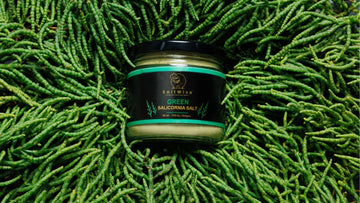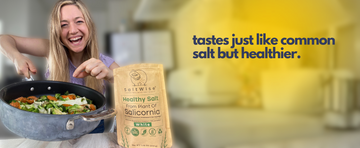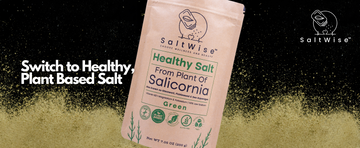
Managing high blood pressure, or hypertension, often feels like navigating a maze of dietary rules and yes, it can be frustrating. One day, you’re told to ditch salt altogether, and the next, someone tells you to steer clear of bananas because of potassium. For example, some will say to completely cut off from salt because of elevated sodium content in them without knowing that SaltWise offers 50% less low sodium salt – Salicornia salt that also comes with additional natural minerals like magnesium, calcium, iron, vitamins and potassium. Salicornia salt is actually the best salt substitute for heart patients.
But the main dilemma is - With so much conflicting information out there, how do you know what’s fact and what’s fiction?
Let’s break down the most common myths about hypertension-friendly diets and uncover the real truths that will actually help you take control of your health.
Myth 1: You Must Completely Cut Out Salt
Fact 1: You don’t need to eliminate salt; just choose the right type of vitamin rich salt and consume it in moderation
Salt often gets a bad reputation when it comes to high blood pressure. It’s true that too much sodium can increase water retention and strain the heart, but your body still needs sodium for proper functioning. The key is choosing a heart-friendly salt like Salicornia salt, which is low in sodium content and rich in minerals like potassium and magnesium. These nutrients help balance sodium levels and reduce its negative impact.
A study published by the American Heart Association (AHA) confirms that while reducing sodium intake is critical, moderate consumption of low-sodium salts can still enhance flavor without increasing blood pressure risks.
You can simply replace regular table salt with Salicornia salt in your cooking to enjoy flavorful meals without any locked-up guilt.
Myth 2: Caffeine Should Be Avoided Completely
Fact 2: Moderate caffeine intake doesn’t necessarily raise blood pressure
Caffeine is often labeled a villain for heart health, but its effects vary from person to person. Studies have shown that while caffeine may cause a temporary spike in blood pressure, it doesn’t lead to chronic hypertension in most people. However, if you’re sensitive to caffeine or consume it excessively, it’s wise to limit your intake.
You can also get your adrenaline boost from the herbal teas or decaf coffee. They are great as a soothing, heart-friendly beverage. And don’t forget to limit your energy drinks, which often contain hidden sodium and sugar.
Myth 3: All Fats Are Bad for Hypertension
Fact 3: Healthy fats are essential and can even help manage blood pressure
Not all fats are created equal! Some are evil and some are really good.
Trans fats and saturated fats found in processed and fried foods can worsen hypertension. However, healthy fats from sources like avocados, nuts, and olive oil have been shown to support heart health. If you want to befriend a healthy fat group, select the Mediterranean diet, which is rich in healthy fats. They show a great example of how good fats can lower blood pressure.
Just drizzle some olive oil over salads instead of using high-sodium salty dressings. And choose unsalted almonds or walnuts over overpoured sodium for a heart-healthy boost.
Myth 4: All Processed Foods Are Off-Limits
Fact 4: While many processed foods are high in sodium, not all of them are harmful
It’s a page 3 news that all processed foods like frozen dinners, canned soups, and packaged snacks often contain excessive sodium, which definitely impacts your heart health. However, some minimally processed foods, such as pre-washed salads or plain frozen vegetables, can still fit into a hypertension-friendly diet.
Always read labels carefully! Look for low-sodium options, choose fresh vegetable over frozen ones and products made with natural ingredients. And use Salicornia salt to season minimally processed foods, giving you control over sodium levels while enhancing flavor.
Myth 5: Sugar Has No Impact on Blood Pressure
Fact 5: Excess sugar is just as harmful as sodium when it comes to hypertension
While most people focus on reducing salt, they often overlook sugar’s role in raising blood pressure. High sugar intake can lead to weight gain, which puts extra strain on the heart. Moreover, sugary beverages like soda and fruit juices can cause insulin resistance, indirectly impacting blood pressure.
A study in the Journal of the American Medical Association found that reducing sugar intake can significantly lower blood pressure in hypertensive individuals.
Replace sugary snacks with fruits like berries or apples, which are naturally sweet and nutrient rich. Opt for unsweetened beverages and naturally flavored water to keep a spike in blood pressure level at bay.
Myth 6: Bananas Are Dangerous for High Blood Pressure
Fact 6: Bananas are actually one of the best foods for managing hypertension
This myth stems from the misconception that potassium-rich foods are harmful. In reality, potassium helps counteract sodium’s effects and relaxes blood vessel walls, lowering blood pressure. Bananas, spinach, and avocados are potassium powerhouses that should be included in a hypertension-friendly diet.
Shove away all the useless myths and blend a banana into a smoothie with spinach and almond milk for a nutrient-packed breakfast and fight the symptoms of hypertension and aging.
Myth 7: Cutting Sodium Means Sacrificing Flavor
Fact 7: With the right seasonings, you can enjoy flavorful meals without excessive sodium
Salt is often considered the primary flavor enhancer, but there are plenty of alternatives that add depth and richness to your dishes. Salicornia salt is an excellent low sodium salt option that enhances taste without compromising heart health. It is the best salt substitute for heart patients that can be combined with herbs, spices, and citrus to create bold and delicious flavors.
Myth 8: All Dairy Products Are Bad
Fact 8: Low-fat dairy can be a great source of calcium and protein for hypertension patients
Full-fat dairy products, like cheese and cream, can be high in saturated fats and sodium. However, low-fat options like Greek yogurt and skim milk are excellent choices for managing blood pressure. These foods provide calcium, which supports healthy blood vessels.
Top Greek yogurt with fresh berries like raspberry and blueberries, and a sprinkle of nuts for a heart-healthy snack. You can also pour skim milk into oatmeal for a creamy, nutrient-rich breakfast.
Myth 9: High Blood Pressure is Only About Salt
Fact: While sodium is important, overall diet and lifestyle play a larger role
Managing hypertension requires a holistic approach. This includes monitoring sodium intake, eating a balanced diet rich in fruits and vegetables, staying active, and managing stress. Foods like fatty fish, whole grains, and leafy greens can all contribute to lower blood pressure.
Try the DASH (Dietary Approaches to Stop Hypertension) diet, which focuses on whole foods and limits sodium, sugar, and unhealthy fats.
Final Platter For The Healthy You!
It doesn't have to feel overwhelming or restrictive to manage hypertension. You can design yourself a sustainable, heart-healthy lifestyle by knowing these facts and busting the myths. Simple changes are always more effective than monstrous, forceful changes.
Start with a simple packet of Salicornia green salt from SaltWise and start implementing the goodness in your life with every licking.
Keep in mind that you have the ability to control your blood pressure. What myths have you spotted today, and which advice will you start with?
Tell us what you think and how you are adopting heart-healthy changes in the comments below!




